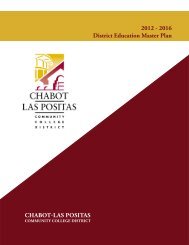City College of San Francisco - California Competes
City College of San Francisco - California Competes
City College of San Francisco - California Competes
You also want an ePaper? Increase the reach of your titles
YUMPU automatically turns print PDFs into web optimized ePapers that Google loves.
STANDARD I<br />
support that plan. The <strong>College</strong> Diversity<br />
Advisory Committee, which reports to the CAC<br />
and has broad-based representation, provides an<br />
avenue for a discussion <strong>of</strong> any topic related to<br />
diversity. For example, discussions in this committee<br />
related to improving the effectiveness <strong>of</strong><br />
the <strong>College</strong>’s instructional programs in addressing<br />
diverse student populations led to the<br />
initiation <strong>of</strong> the Multicultural Infusion Project.<br />
That project has involved many faculty and<br />
administrators in various initiatives to improve<br />
classroom instruction using multicultural<br />
instructional methodologies and to increase the<br />
diversity <strong>of</strong> the teaching and support staff.<br />
[Refs. 5, 10]<br />
“Listening Sessions” have become a regular part<br />
<strong>of</strong> the review and analysis <strong>of</strong> major documents<br />
and initiatives. The <strong>College</strong> Shared Governance<br />
leaders responsible for developing a document or<br />
initiative engage in a dialog with any interested<br />
members <strong>of</strong> the community who attend the<br />
listening sessions. There are usually several<br />
sessions scheduled at various sites throughout<br />
the District. These sessions are widely publicized<br />
and are open to all <strong>College</strong> faculty, students, and<br />
staff, as well as the <strong>San</strong> <strong>Francisco</strong> community<br />
as a whole. The discussions are carefully documented<br />
and the initiatives or documents under<br />
consideration are frequently modified based on<br />
these sessions. Two recent examples <strong>of</strong> this type<br />
<strong>of</strong> interactive dialog were the listening sessions<br />
held prior to the final approval <strong>of</strong> the Strategic<br />
Plan and the listening sessions conducted as<br />
part <strong>of</strong> the institution-wide review and evaluation<br />
<strong>of</strong> the <strong>College</strong>’s Shared Governance<br />
policies and procedures.<br />
The Chancellor’s Annual Report to the<br />
Community is another excellent means through<br />
which the <strong>College</strong> communicates evidence <strong>of</strong><br />
learning outcomes, as well as program and institutional<br />
performance. A quarterly Community<br />
E-Bulletin, which features important <strong>College</strong><br />
accomplishments and news, has recently been<br />
added to the <strong>College</strong>’s efforts to communicate<br />
with external constituencies. These two avenues<br />
for advising the community about CCSF quality,<br />
funding, and activities are valuable additions to<br />
the successful strategies the <strong>College</strong> has been<br />
using for many years—including televising its<br />
Board meetings, sending the Schedule <strong>of</strong> Classes<br />
out to all residences in the <strong>City</strong>, disseminating<br />
many documents at Board meetings for the<br />
public to take home, and making a great deal<br />
<strong>of</strong> information available online. [Refs. 13, 14]<br />
Additional findings and analysis<br />
on Standards I.A.1-4<br />
<strong>City</strong> <strong>College</strong> <strong>of</strong> <strong>San</strong> <strong>Francisco</strong> has established<br />
student learning programs and services that<br />
reflect the <strong>College</strong>’s purposes, character, and<br />
diverse student populations. CCSF serves over<br />
98,000 students, split almost evenly between<br />
credit and noncredit instructional modes, in<br />
an urban, multi-campus institution at 12 major<br />
campuses and nearly 200 sites throughout the<br />
<strong>City</strong> and County <strong>of</strong> <strong>San</strong> <strong>Francisco</strong>. The student<br />
population has an average age <strong>of</strong> 33 (credit and<br />
noncredit combined) and includes more female<br />
than male students. The ethnic demographics<br />
<strong>of</strong> students in credit and noncredit programs<br />
includes a plurality <strong>of</strong> Asian students (35 percent),<br />
20 percent non-Hispanic White, 20<br />
percent Hispanic/Latino/a, 7 percent African-<br />
American non-Hispanic, 5 percent Filipino, and<br />
smaller numbers <strong>of</strong> other Pacific Islanders and<br />
Native Americans, as well as other non-identified<br />
students (approximately 10 percent). Campus<br />
programs are targeted to the needs <strong>of</strong> the populations<br />
in the surrounding community. Several<br />
<strong>of</strong> the campuses focus on specific components<br />
<strong>of</strong> the <strong>College</strong>’s instructional missions (e.g.,<br />
Evans Campus addresses primarily vocational<br />
and occupational education and John Adams<br />
Campus is a center for health pr<strong>of</strong>essions training<br />
and adult basic education). Many <strong>of</strong> the<br />
noncredit courses <strong>of</strong>fered at the campuses<br />
address the language skills, basic skills, and<br />
specific vocational skills appropriate to local<br />
student populations. Credit <strong>of</strong>ferings also vary<br />
by campus based on the needs <strong>of</strong> the student<br />
populations. For example, the Fort Mason<br />
Campus <strong>of</strong>fers primarily studio art courses while<br />
the Castro/Valencia Campus <strong>of</strong>fers a variety <strong>of</strong><br />
general education courses with a heavy emphasis<br />
on foreign languages for an adult evening student<br />
population. Credit and noncredit business<br />
courses are <strong>of</strong>fered at many sites including<br />
John Adams and Downtown. The Mission,<br />
Chinatown/North Beach, John Adams, and<br />
98 CITY COLLEGE OF SAN FRANCISCO







